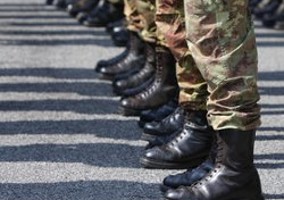Inevitably as we approach Remembrance Sunday there was the annual pop at military charities, which this year was on the subject of reserves. Specifically that military charities have held too much back.
This year both the Times and Sky News began the week with a focus on how much money the largest military charities are "sitting on" or, to put it another way, holding back some money.
The central criticism seems to be “why do all this fundraising now, when you have all this unspent cash?” At first this seems fair. The six-figure sums involved are eye watering if you’re not familiar with the scale and costs involved in long-term rehabilitation services.
Flawed analysis
There are a number of issues with the Times’ analysis. Firstly the Times has used the figure for total funds available, and not one for “unrestricted” or “free” reserves. This means it includes any funds where the donor has restricted the use of the money for a specific project, or funds where the charity is raising money for a capital project, such as a new rehabilitation centre, among other things and is not a representation of how much money it has to hand.
For example, the second charity in the Times’ list, The Black Stalk Charity, saw its reserves increase by 591 per cent or from £28m in 2014 to £195m in 2018. This clearly looks like a massive growth, where there are some questions to answer.
But it is actually a relatively young organisation that was established in 2011 to raised funds and build facilities for the Defence and National Rehabilitation (DNRC) Programme. Its income has also increased significantly over the same period, a relevant detail which is not captured by comparing is reserves position in 2014 with 2018.
The charity now plans to increase its spending and bring to a close its large fundraising appeal. Information that is in its annual report, but not the Times news story, which says: “2019 is the year the fundraising campaign for the Defence establishment will be brought to a close, following what will be the successful realisation of the £300m appeal total.”
Secondly, the figures in the Times don’t seem to have been adjusted for inflation. For example the 2014 figure for the Royal Star and Garter Homes quoted in the Times is £127m but when it is adjusted for inflation it becomes £140m, just £5m below the 2018 figure.
Problems with charity accounts
But charities have not made things easy for themselves.
I have some sympathy with journalists and members of the public trying to answer some seemingly straightforward questions: “How much is this charity putting aside for emergencies? Why? And is it enough?”
Often the reserves policy feels formulaic and full of jargon, and as if it has been written to fulfil an accounting requirement and not answer the questions above.
It’s literally our bread and butter here at Civil Society Media and the lack of a consistent approach to reporting and the confusing way things are worded means we often puzzle over what a charity means by its reserves policy.
Indeed in a recent article for Charity Finance magazine, Helena Wilkinson, a partner at Price Bailey, assessed the openness of charity reporting across the board and concluded that when it came to explaining their reserves position the largest 100 charities are pretty poor.
“All charities set out their reserves policy but only 23 per cent explained their reserves in detail,” she wrote. “None provided a breakdown of each element of the reserves individually in pounds with a detailed explanation to arrive at the total free reserves figure.
“Three-quarters had a very brief reserves policy, mainly quoting working capital and income risks as reasons to hold reserves, with very little additional information on how that translated into the figure then stated for free reserves.”
Cobseo: ‘Misleading and damaging claims’
The umbrella body for military charities, Cobseo The Confederation of Service Charities, issued a statement yesterday condemning the coverage and accusing the Times and others of misleading people. It also had a letter printed in the paper.
General Sir John McColl, chairman of Cobseo, The Confederation of Service Charities, said: “Recent news looking at Service Sector Charity has made a number of misleading and damaging claims regarding levels of reserves. In line with broader charity sector guidelines on holding responsible levels of reserves, charities should hold a level that means that they can reasonably safeguard against the risks identified by their trustees within their organisation. At the heart of all reserve policy planning should be ensuring that future beneficiary needs can be met.
He added that: “The Service Charity Sector provides essential support to the Armed Forces Community and will continue to do so for generations to come. By presenting a misleading picture of the finances of the sector, such support can be undermined, which can only logically lead to diminished support available for beneficiaries.”
Unfortunately this statement will have passed many of the original readers by because it appeared a day after the original coverage.
Charities, especially representative bodies, must find ways to get their messages and any counter narratives to the right people much sooner.
Risk of government or regulatory interference?
This matters because the angle for most of the follow-up coverage yesterday, was not: “Cobseo defends wonderful military charities” but about the calls, suggestions and hints from various MPs that charities should be somehow made to spend their money.
The new government department, the Office for Veterans’ Affairs, seems to have been set up with a remit partly to help co-ordinate work done by charities and yesterday one of its ministers was quoted in the Times as urging closer working to “reduce duplication” within the sector.
There is understandably nervousness in the sector every time a government minister suggests closer working as it is much easier to say than do, but it is hardly surprising that they do when presented with analysis like that in the Times on Monday.
The independence of the sector is to be treasured and protected. Rightly, there are no fixed rules for how much charities should spend or where they should spend it. This is to take account the breadth of the sector and different needs of different charities and different points in their life.
But this is a privilege, and if the sector cannot be seen to be raising and spending money properly then it will find itself under increased regulatory scrutiny and facing the prospect of tighter rules.
Finally, I think it’s also worth highlighting that whenever a large well-known charity collapses, the same people in media and politics will be clamouring for charities to be forced to hold on to more of their money for emergencies. To avoid knee-jerk reactions from policy-makers and break this cycle charities must be clearer and firmer in challenging damaging narratives about the sector before they take hold.
|
Related articles












